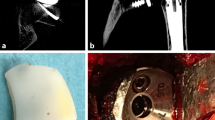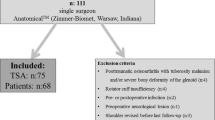Abstract
Purpose
Radiolucent lines (RLL) are frequent findings around cemented all-polyethylene glenoid implants. The present study evaluates the frequency, extend and the clinical impact of RLL around a cemented two-pegged glenoid implant with special focus on the influence of preoperative glenoid morphology. Our hypothesis was that glenoid morphology does not affect clinical outcome and RLL in the investigated setting.
Methods
Between 2003 and 2008, a total of 113 cases of total shoulder arthroplasties (Affinis, Mathys Ltd Bettlach, Switzerland) were performed in three surgical centres using a pegged cemented polyethylene glenoid component. A total of 90 cases could be evaluated clinically and radiographically. Clinical outcome was analysed using the constant score (CS) and range of motion assessment. Radiographic evaluation was performed in true anterior–posterior and axial views with special focus on loosening and RLL. Further, preoperative glenoid morphology was documented and its correlation to radiolucent lines and clinical outcomes was evaluated.
Results
At a mean of 58.8 (range 31.2–92.5)-month follow-up the CS improved from 21.5 points preoperatively to 62.3 points postoperatively. Radiolucent lines were found in 76.6 % of cases. If present, RLL were located at the backside of the implant (74.4 %) in the majority of the cases not around the pegs (10 %). There was no significant correlation between RLL and clinical outcome or follow-up time. The amount and extend of RLL were correlated to glenoid morphology with significantly higher values for glenoid types B2 and C according to Walch in comparison to glenoid types A1, A2 and B1.
Conclusions
RLL did not affect clinical outcome and did not correlate with the follow-up time. Patients with glenoid morphology types B2 and C showed significantly worse radiographic results.
Level of evidence
Level IV case series study.


Similar content being viewed by others
References
Fox TJ, Cil A, Sperling JW, Sanchez-Sotelo J, Schleck CD, Cofield RH (2009) Survival of the glenoid component in shoulder arthroplasty. J Should Elb Surg 18:859–863
Boileau P, Avidor C, Krishnan SG, Walch G, Kempf J-F, Mole D (2002) Cemented polyethylene versus uncemented metal-backed glenoid components in total shoulder arthroplasty: a prospective, double-blind, randomized study. J Should Elb Surg 11:351–359
Fucentese SF, Costouros JG, Kühnel S-P, Gerber C (2010) Total shoulder arthroplasty with an uncemented soft-metal-backed glenoid component. J Should Elb Surg 19:624–631
Taunton MJ, McIntosh AL, Sperling JW, Cofield RH (2008) Total shoulder arthroplasty with a metal-backed, bone-ingrowth glenoid component. Medium to long-term results. J Bone Joint Surg 90:2180–2188
Martin SD, Zurakowski D, Thornhill TS (2005) Uncemented glenoid component in total shoulder arthroplasty. Survivorship and outcomes. J Bone Joint Surg Am 87:1284–1292
Anglin C, Wyss UP, Nyffeler RW, Gerber C (2001) Loosening performance of cemented glenoid prosthesis design pairs. Clin Biomech (Bristol, Avon) 16:144–150
Szabo I, Buscayret F, Edwards TB, Nemoz C, Boileau P, Walch G (2005) Radiographic comparison of flat-back and convex-back glenoid components in total shoulder arthroplasty. J Should Elb Surg 14:636–642
Lazarus MD, Jensen KL, Southworth C, Matsen FA (2002) The radiographic evaluation of keeled and pegged glenoid component insertion. J Bone Joint Surg Am 84-A:1174–1182
Edwards TB, Labriola JE, Stanley RJ, O’Connor DP, Elkousy HA, Gartsman GM (2010) Radiographic comparison of pegged and keeled glenoid components using modern cementing techniques: a prospective randomized study. J Should Elb Surg 19:251–257
Brems J (1993) The glenoid component in total shoulder arthroplasty. J Should Elb Surg 2:47–54
Sperling JW, Cofield RH, Rowland CM (1998) Neer hemiarthroplasty and Neer total shoulder arthroplasty in patients 50 years old or less. Long-term results. J Bone Joint Surg Am 80:464–473
Sperling JW, Cofield RH, Rowland CM (2004) Minimum fifteen-year follow-up of Neer hemiarthroplasty and total shoulder arthroplasty in patients aged 50 years or younger. J Should Elb Surg 13:604–613
Norris BL, Lachiewicz PF (1996) Modern cement technique and the survivorship of total shoulder arthroplasty. Clin Orthop Relat Res 326:76–85
Walch G, Young AA, Melis B, Gazielly D, Loew M, Boileau P (2011) Results of a convex-back cemented keeled glenoid component in primary osteoarthritis: multicenter study with a follow-up greater than 5 years. J Should Elb Surg 20:385–394
Throckmorton TW, Zarkadas PC, Sperling JW, Cofield RH (2010) Pegged versus keeled glenoid components in total shoulder arthroplasty. J Should Elb Surg 19:726–733
Kasten P, Pape G, Raiss P, Bruckner T, Rickert M, Zeifang F, Loew M (2010) Mid-term survivorship analysis of a shoulder replacement with a keeled glenoid and a modern cementing technique. J Bone Joint Surg Br 92:387–392
Raiss P, Schmitt M, Bruckner T, Kasten P, Pape G, Loew M, Zeifang F (2012) Results of cemented total shoulder replacement with a minimum follow-up of 10 years. J Bone Joint Surg 94:e1711
Walch G, Badet R, Boulahia A, Khoury A (1999) Morphologic study of the glenoid in primary glenohumeral osteoarthritis. J Arthroplast 14:756–760
Gerber C, Costouros JG, Sukthankar A, Fucentese SF (2009) Static posterior humeral head subluxation and total shoulder arthroplasty. J Should Elb Surg 18:505–510
Mansat P, Briot J, Mansat M, Swider P (2007) Evaluation of the glenoid implant survival using a biomechanical finite element analysis: influence of the implant design, bone properties, and loading location. J Should Elb Surg 16:S79–S83
Constant CR, Murley AH (1987) A clinical method of functional assessment of the shoulder. Clin Orthop Relat Res 214:160–164
Yian EH, Ramappa AJ, Arneberg O, Gerber C (2005) The Constant score in normal shoulders. J Should Elb Surg 14:128–133
Molé D, Roche O, Riand N, Lévigne C, Walch G (2009) Cemented glenoid components: results in osteoarthritis and rheumatoid arthritis. In: Walch G, Boileau P (eds) Shoulder Arthroplasty. Springer, Heidelberg, pp 163–176
Franklin JL, Barrett WP, Jackins SE, Matsen FA (1988) Glenoid loosening in total shoulder arthroplasty. Association with rotator cuff deficiency. J Arthroplast 3:39–46
Neer CS, Kirby RM (1982) Revision of humeral head and total shoulder arthroplasties. Clin Orthop Relat Res 170:189–195
Torchia ME, Cofield RH, Settergren CR (1997) Total shoulder arthroplasty with the Neer prosthesis: long-term results. J Should Elb Surg 6:495–505
Edwards TB, Sabonghy EP, Elkousy H, Warnock KM, Hammerman SM, O’Connor DP, Gartsman GM (2007) Glenoid component insertion in total shoulder arthroplasty: comparison of three techniques for drying the glenoid before cementation. J Should Elb Surg 16:S107–S110
Choi T, Horodyski M, Struk AM, Sahajpal DT, Wright TW (2013) Incidence of early radiolucent lines after glenoid component insertion for total shoulder arthroplasty: a radiographic study comparing pressurized and unpressurized cementing techniques. J Should Elb Surg 22:403–408
Barwood S, Setter KJ, Blaine TA, Bigliani LU (2008) The incidence of early radiolucencies about a pegged glenoid component using cement pressurization. J Should Elb Surg 17:703–708
Haines JF, Trail IA, Nuttall D, Birch A, Barrow A (2006) The results of arthroplasty in osteoarthritis of the shoulder. J Bone Joint Surg Br 88:496–501
Nuttall D, Haines JF, Trail IA (2009) The effect of the offset humeral head on the micromovement of pegged glenoid components: a comparative study using radiostereometric analysis. J Bone Joint Surg Br 91:757–761
Friedman RJ (1992) Glenohumeral translation after total shoulder arthroplasty. J Should Elb Surg 1:312–316
Wirth MA, Loredo R, Garcia G, Rockwood CA, Southworth C, Iannotti JP (2012) Total shoulder arthroplasty with an all-polyethylene pegged bone-ingrowth glenoid component: a clinical and radiographic outcome study. J Bone Joint Surg 94:260–267
Acknowledgments
The study was approved by the institutional review board, international ethics committee Freiburg, Germany (code: (feki) 012/1399).
Author information
Authors and Affiliations
Corresponding author
Rights and permissions
About this article
Cite this article
Greiner, S., Berth, A., Kääb, M. et al. Glenoid morphology affects the incidence of radiolucent lines around cemented pegged polyethylene glenoid components. Arch Orthop Trauma Surg 133, 1331–1339 (2013). https://doi.org/10.1007/s00402-013-1813-7
Received:
Published:
Issue Date:
DOI: https://doi.org/10.1007/s00402-013-1813-7




